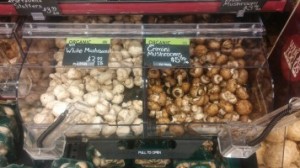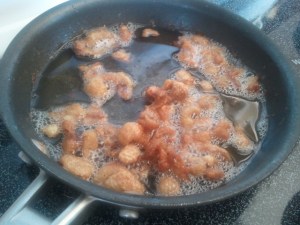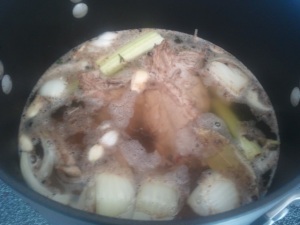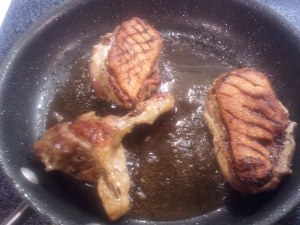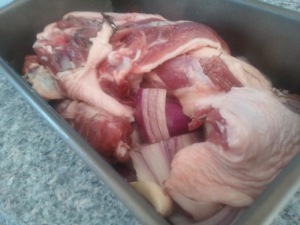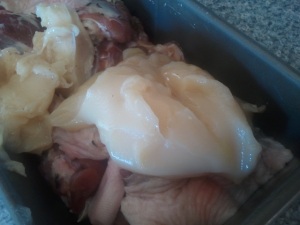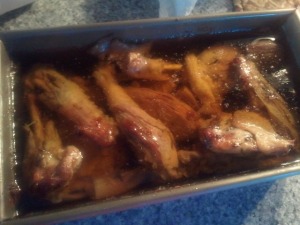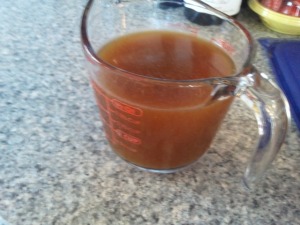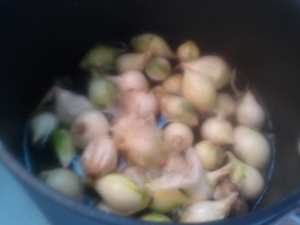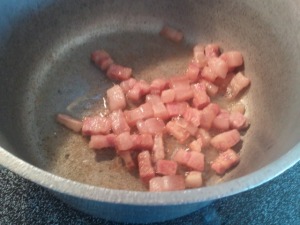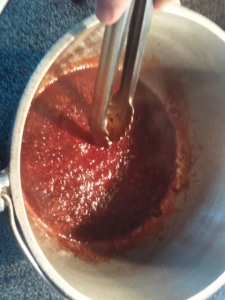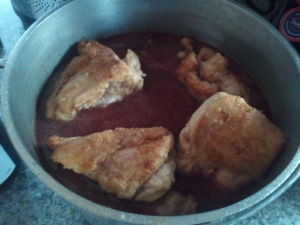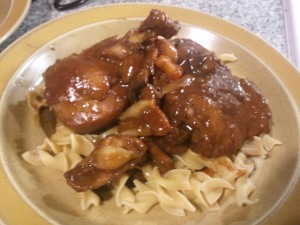As fun and interesting it is to delve into realms of history and legend that so many of these classic French preparations have seemed to garner, it’s almost ever more intriguing to find one that has little to say for itself. Thus is my experience with the preparation of Coquille St. Jacques, a term which has been says translates to “Saint James’s Scallops,” deriving an interesting little tale to the origin. The story goes that the holy Saint James, in his travels, saved a night who had fallen into the river; upon emerging, the night was covered in scallop shells (there is also a story of a knight’s horse that fell in and emerged with scallops). As such, Saint James’ emblem became that of the scallop shell, which on its own is a true fact, and thus lending itself to the name of the dish.
Whether these tales are true, or if they really has any forbearance on the dish’s name, is up to debate. What we can say is that Saint Jacques has become the accepted name for a certain French scallop, and that the term “coquille” is culinary used for a number of recipes that are baked or broiled inside a scallop shell, which when cleaned has made a very durable and trusty cooking utensil for hundreds of years (there’s an interesting anecdote to begging poor or monks who would travel with one tied around their neck and use to scoop food). These dishes are oft composed of the main ingredient chopped up and covered in a creamy wine sauce, thickened much like gravy, and then broiled with cheese as-is or on top of a bed of other ingredients. Methods for coquille st-jacques has found the scallops cooked alone or on top of duxelle (a blend of shallots, garlic, and mushroom sautéed into a paste), diced or whole, until golden and bubbly.
A Word On…
Scallops: Here is the question on how one puts this dish together; do we do the classic, rustic coquille which consists of a mass of goeey cheese sauce mixed with chopped up shellfish meat, or do we leave large rounded disks with an elegant garnish to display in a more refined manner, thus highlighting the meaty seafood? If one goes for the former, tiny Bay Scallops are likely your game, much sweeter and more flavor without having to worry about the structure. However, after my few months away from the blog game, I feel like I want to present the more sophisticated style of my first dish in a while; not to mention, if I’m going to cook with a good quality scallop, I want it to be able to shine properly, so bigger Sea Scallops it is.
I buy them fresh from a good distributor, not frozen and definitely not the ‘wet packed’ scallops that many people warn about. To make sure it doesn’t have any of that extra moisture that could ruin its structure when cooking, I pat and let them sit on some paper towels before the poaching. The results… well let’s see.
Of course, die hard recipe reproducers would look to get true St. Jacques Scallops from France; of which I have no clue how to do in the States besides shipping in frozen, so I’ll stick to some decent fresh ones instead.
Mushrooms: though their inclusion is fully optional, every recipe I’ve found that uses them points almost exclusively to white buttons, which I was want to follow. Giving myself a few extra seconds at the store, in front of the bins, I could not help but think that if this was made in the French countryside, around the Loire, from ingredients on hand, would it have been a ‘white button’ or some available brown-topped, perhaps wild mushroom? Some version of the latter feels more sincere, so at the very least I decided to buy some Criminis to get more flavor in.
 Sauce: The sauce used for this is somewhat intriguing compared to other ones I’ve worked with in the past. It’s a roux-thickened recipe, much like with three of the classic mother sauces and gravy, but it uses no stock, no milk as its base, some cream yes but that’s more for fortification at the end (like butter); the liquid component is entirely based on wine that the scallops are poached in before baking. Flavor wise it ends up similar to a classic beurre blanc, but oh what a different texture.
Sauce: The sauce used for this is somewhat intriguing compared to other ones I’ve worked with in the past. It’s a roux-thickened recipe, much like with three of the classic mother sauces and gravy, but it uses no stock, no milk as its base, some cream yes but that’s more for fortification at the end (like butter); the liquid component is entirely based on wine that the scallops are poached in before baking. Flavor wise it ends up similar to a classic beurre blanc, but oh what a different texture.
That ramble out of the way, the poaching liquid itself offers another choice to us, as I’ve seen in my searchings: Wine or Vermouth. Many have used either or, or combinations of the two, thus leading us to debate; my own curiosity has me wondering what the vermouth would taste like, and why it’s included, however contrary to that I don’t think I’d want to create an all-vermouth sauce and poaching liquid unless I had some good quality alcohol, as opposed to the terrible mass-produced crap that’s usually in my bar simply be destined for thinning out in cocktails. Thus I settled for an almost equal portioned blend of the two, so that I could add just that little bit of complexity, botanical depth, and richness vermouth contributes. Though, I would suggest that, unlike me, you use a proper WHITE vermouth in your own experiments (sadly we ran out, so red it is).
Cheese: Not too much of a commonality in recipes, I’ve seen people use Swiss, Parmesan, Gruyere, mixes, you name it. Some sprinkle just on top, some melt into the sauce, if not both; which is where I start, as I feel like the sauce should stay a simple gravy of the thickened cooking liquid, only using cream to bolster the texture. Cheese is made to be gratineed over the top, and though there seems to not be anything SPECIFICALLY required, gruyere just seems to fit the bill best, both in its melting properties and the common use in French cuisine where cheese is concerned.
Coquille: Very likely, you probably don’t have a scallop shell you can use for cooking at home. Ramekins work well, though, or any other similar small baking dish that can be stuck in a super-hot oven and broiled with.
Coquilles St-Jacques
4 Tb Butter
3 Shallots, Chopped
4 cloves Garlic, Chopped
1 cup Chopped White Button or Crimini Mushrooms
¼ bunch Parsley
12 Sea Scallops
¾ cup Dry White Wine (French preferred)
½ – ¾ cup Dry White Vermouth
2 Tb Flour
3 Tb Cream
¼ cup Grated Gruyere
Salt and Pepper
Directions
- Heat a sauté pan to medium/med-high, tossing in 2 Tb of Butter and 2 of the Shallots.

- Cook 1-2 minutes until it begins to soften, adding in the Garlic and chopped Mushrooms.

- Heat, stirring often, until browned nicely throughout and broken down. Season with salt, pepper, and most of the Parsley Leaves, minced. Reserve.

- Gently prepare your Scallops, slicing carefully in half to produce two thin disks.

- In a separate, wide pan, combine the Wine, Vermouth, Parsley Stems, and the rest of the Shallots, heating until just barely at a simmer.

- Arrange the scallops in the pan so that the liquid only just covers them (or gets close to the top), letting them sit in the warm but not boiling poaching liquid 2-3 minutes. You may need to flip them halfway through to ensure even cooking.
- Remove scallops, reserve on the side, and strain the resulting wine and scallop Stock.
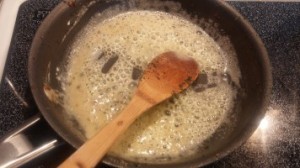
- In the pan one cooked mushrooms in, add the rest of the butter with the heat on medium. Once melted, whisk in the Flour.
- Let sit on hit, whisking often, until it lightens slightly in color, 1-3 minutes. Slowly pour in the still-warm wine stock, mixing constantly to incorporate.

- Let heat for a minute or two until thickened slightly; if notable too thick, add in more wine to thin into a proper sauce. Season salt and pepper, finish with the Cream.
- Heat oven to 475F.

- Start arranging your ingredients on the Coquille or other ramekin-like serving vessel, starting with a mound of the sautéed mushroom duxelle and some of the sauce.

- Carefully layer the poached scallop coins on top in a pleasing array, spooning the rest of the sauce overhead. Garnish with Gruyere and move to the oven.
- Roast until the sauce is melty and the top has bruleed to a beautiful golden edge, about 5-15 minutes depending on cooking vessel and other factors.

- Remove, garnish with freshly chopped parsley, and serve alongside toasted baguette.
The Verdict
 There’s a very intriguing ‘rule’ in French and Italian cooking that states one should never plate seafood with cheese; there are of course exceptions to every rule, but it’s usually seen with subtle manipulations, here most often using only the lightest hints of parmesan to bolster a bit of richness in a white fish or scallop dip. Which is why, when eating, I found this particular dish so intriguing, in light of not only this rule but of what I know of France’s culinary distinctions. Here we’re taking a scallop, an ingredient that needs gentle treatment and is most commonly partnered with delicate flavors so as to highlight its veil of sweetness and easy-to-dismiss flavors of the sea, and completely smothering it in garlicky mushrooms, a thick and tart cream sauce, and the strong European cheddar that is Gruyere.
There’s a very intriguing ‘rule’ in French and Italian cooking that states one should never plate seafood with cheese; there are of course exceptions to every rule, but it’s usually seen with subtle manipulations, here most often using only the lightest hints of parmesan to bolster a bit of richness in a white fish or scallop dip. Which is why, when eating, I found this particular dish so intriguing, in light of not only this rule but of what I know of France’s culinary distinctions. Here we’re taking a scallop, an ingredient that needs gentle treatment and is most commonly partnered with delicate flavors so as to highlight its veil of sweetness and easy-to-dismiss flavors of the sea, and completely smothering it in garlicky mushrooms, a thick and tart cream sauce, and the strong European cheddar that is Gruyere.
And the damn thing works. For despite this rich, gut warming bowl of goodness, the scallop’s flavors are never fully covered, and the portions leave its meat in the strong point, allowing us to enjoy its well-cooked texture, the sweetness coming to underlay against the creamy cheese and sauce, with mushrooms dancing in behind to say hello and make our taste buds happy. Though they might not be a requirement, I am happy I went for the version with the duxelle, as well as keeping big pieces of scallop vs chopped, though I’m sure that would have been its own scrumchy delight. It does need to be eaten with bread or something else though, for a complete course, too bad I forgot to get a baguette (had some English muffins though, so it worked out!).
It’s not hard to reason that sake goes very well with fish and seafood, considering the well famed Japanese cuisine. Though one might not think it, considering most sake’s very earth-bound flavors of woods, fungus, and earth mixed with the rice’s sweetness. But when we get into the more aromatic and refined styles of Gingo and Daigingo, where the rice grain has more of its heavier outer layers polished down, we find notably lighter-bodied ‘wines’ with those characteristic flavors of the sea mixed with fruit and floral yeasts. If we were to choose a bottle that was only halfway up this sake totem pole of refinement, mainly Gingos, then we would still hold onto some of those earthy flavors, which in my opinion make it quite the appealing pair to enjoy alongside this medium-lightweight, mushroomy seafood dish.
 My Bottle: Sho Chiku Bai’s Junmai Gingo Sake
My Bottle: Sho Chiku Bai’s Junmai Gingo Sake
I’ll admit a noted disappointment on first sip, as I had hoped for it to reveal more flavors of fleshy fruit, or perhaps some zesty aromatics, but nonetheless it shone itself as a proper, standard Junmai Gingo. The ‘weight’ of the drink was a noted step down from regular Junmai sake (which is an interesting thing to taste one next to the other; unlike other drinks, where shifts in style happen more smoothly and gradually, one can very easily feel a drop in aromatic strength and body weight between the different sake styles), and contained the smooth flavors of barley and mushrooms to play with the palette without overpowering the light scallops. The flavors and weights ended up meshing quite nicely, with just a bit of that creamy rice flavor that blended into the creamy white scallop. Overall, much like my last sake pairing with the duck, a surprisingly successful match after opening.
Sticking to the NW region, along the river Loire and close to the sea, I so much want to use a Sancerre or Muscadet, but the body’s just too light and flavors too crisp for my liking in this case. A Vouvray, however, based on the Chenin Blanc, brings a bit more weight to combat the slightly heavier sauce and mushrooms, a bit more of a richer background, while still holding notable acid (as Chenin and Rieslings are like to do) to cut through the cream and brighten the seafood. Not to mention many Vouvray (note I’m sticking with the generic as opposed to choosing a specific style, regional or otherwise) contain a bit of sweetness which I think would combat the saltiness of the cheese and scallops beautifully, if done right of course.


